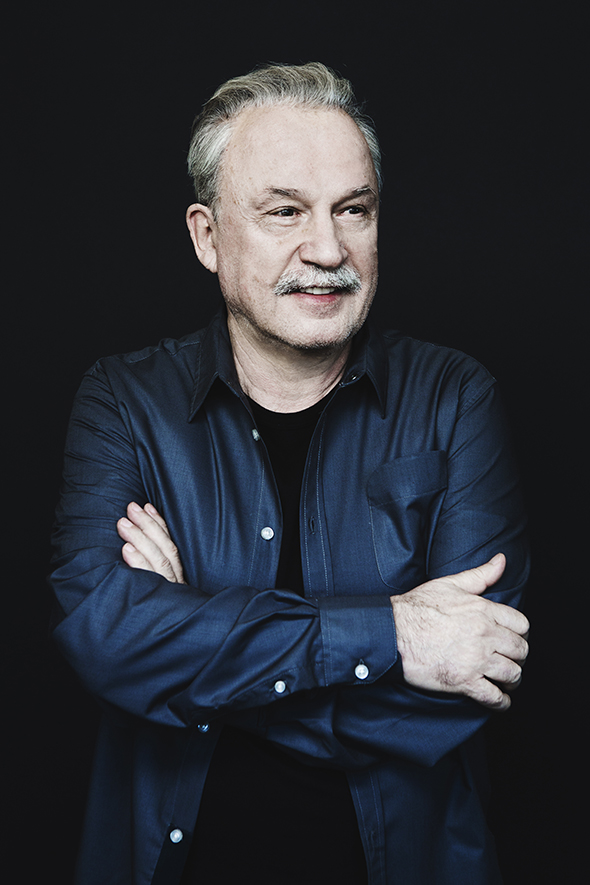Back In Business

When Giorgio Moroder enters a room filled with music industry folks, his appearance is met with a standing ovation. The genteel Moroder, who with thinning white hair and a bushy moustache looks like a kindly great uncle, receives the applause humbly, smiling, his eyes sparkling. For the layperson, Moroder’s presence means next to nothing. And why should it? The 75-year-old Italian (by way of Germany) music innovator has been dormant for a good 30 years. That is, until Daft Punk decided to rustle him up and stick him in front of a microphone so he could tell his life story on their track, “Giorgio By Moroder” on the duo’s 2013 game-changing album, Random Access Memories. On the track, Moroder, in his sing-song Italian/German accented English, quietly tells his tale while Daft Punk plays a backing track that pays tribute to Moroder’s hefty body of work.
The bulk of Moroder’s success happened from the mid-‘70s to the mid-‘80s when he looked like the prototype “Mr. Ka-tear” of the popular ‘70s television show, Welcome Back, Kotter. During that time he invented disco, marked by his work with Donna Summer on the enduring “Love To Love You Baby.” He made smash hits for Blondie and David Bowie. He set the standard for soundtracks with Midnight Express, Scarface, and Flashdance. He wrote the official song for the 1984 Olympics. And that only scratches the surface of his accomplishments. In his collection of knick-knacks, he has three Academy Awards, four Grammys, and four Golden Globes.
There are more awards, as well as select framed platinum and gold records, littering Moroder’s luxury high-rise apartment in the affluent Wilshire Corridor in Los Angeles. Moroder has sold millions upon millions of records. He has been comfortable for a long time. During his “retirement,” he has indulged himself in his artwork and had time to help design an Italian sports car —the Cizeta-Moroder — and a cognac bottle. He has also worked on an idea to build a pyramid-shaped apartment complex in Dubai. He moves in circles of the wealthy and influential that outsiders are unaware of existing. He wasn’t expecting to become an in-demand DJ, not at his age, let alone be releasing an album of brand new material, Déjà Vu, where top-name collaborators clamored to be featured on his songs.
“When I was asked to DJ 10 years ago, I thought, ‘I’m a producer, I’m a composer, I’m not a DJ.’ At the time, DJs were just DJs. Now, DJs are superstars,” says Moroder who aligns himself with that elite group. After a brief appearance for Louis Vuitton and another in Cannes for Elton John and amfAR, Moroder’s first real gig was for Red Bull Music Academy in 2013. Since then Moroder has become a regular name on big festival bills and major clubs worldwide.
“An hour is great, an hour and 15 minutes is ideal,” says Moroder of his DJ sets, which are pulled from his wealth of productions and programmed using Ableton Live for more creativity. “It’s quite tiring. You have to dance. You have to move.”
On Déjà Vu Moroder taps into the abilities of his A-list collaborators: Sia, Britney Spears, Charli XCX, Kelis, Kylie Minogue, Matthew Koma, Mikky Ekko, Foxes, and Marlene to make a very current album that is in step with the EDM megastars with whom he is lumped. “The original idea I had was disco songs,” he says. “Then I thought buyers are young, they are used to EDM dance, so I tried to combine modern sounds with guitars and strings to give a feel of the old disco times, but not emphasize it too much.”
What people will buy is at the forefront of any of Moroder’s creations, music or otherwise. “You still have to live,” he points out matter-of-factly, more interested in quantifiable success than critical. With the singles released from Déjà Vu hitting tops of charts internationally, Moroder still has the touch. There are glimmers of his synthesizer-driven, robotic yet filmic arrangements throughout the album, as much as there are bold and shiny beats and drops that match today’s sounds.
Says Moroder of his 40+ year-old recordings versus his fresh ones, “You could do it as good as you could, but when the session was over, you could not change a note or do a thing, so it was more natural. Now it has to be perfect because people are expecting it. You have to have every instrument at the same volume. You can use the computer to make intentional little mistakes, but it doesn’t sound human. That makes things, especially in EDM, a little mechanical.”
Like all of today’s music, Déjà Vu, has multiple musical inputs. A song travels around the world for input before it comes back to Moroder. This is very removed from his beginnings in Germany, holed up with lyricist Peter Bellotte and Donna Summer, just vibing.
“The vocal is the most stressful thing,” Moroder points out. “I’ve worked with major acts like David Bowie. What am I going to tell him? That high note was not good? The other thing is, when people are in the studio you never know if something is final or if you could do it better. On the other hand, you’re more objective if somebody sings without you. You know immediately if you like it or not. But then, Kelis wrote the lyrics and top line for ‘Back & Forth’ with me in the studio, sang it two or three times and that was it. I didn’t touch her voice at all.”
“I must say, it is unusual to be back in pop, “he continues. “Sometimes I think, ‘Is it really me they are talking about?’ I’m 75, I’m back in business, and I love it.”
Text by Lily Moayeri
Photograph by RCA Records